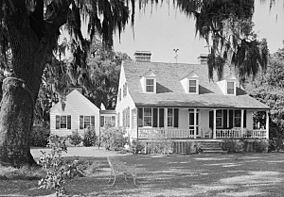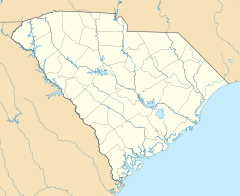Charles Pinckney National Historic Site facts for kids
Quick facts for kids Charles Pinckney National Historic Site |
|
|---|---|

Snee Farm House, 1940
|
|
| Location | Mount Pleasant, South Carolina, USA |
| Nearest city | Charleston, South Carolina |
| Area | 28.45 acres (11.51 ha) |
| Established | September 8, 1988 |
| Visitors | 45,254 (in 2011) |
| Governing body | National Park Service |
| Website | Charles Pinckney National Historic Site |
|
Snee Farm-Charles Pinckney National Historic Site
|
|
| Nearest city | Mount Pleasant, South Carolina |
| Built | 1824 |
| NRHP reference No. | 73001702 (original) 100007048 (increase) |
| Significant dates | |
| Added to NRHP | April 13, 1973 |
| Boundary increase | October 10, 2021 |
| Designated NHL | November 7, 1973 |
The Charles Pinckney National Historic Site is a special place in Mount Pleasant, South Carolina. It's managed by the National Park Service, which protects important historical sites in the United States. This site keeps alive a part of Snee Farm, which was once a large farm and country home belonging to Charles Pinckney.
Charles Pinckney (1757-1824) was a very important person in American history. He came from a well-known family in South Carolina. He fought in the American Revolutionary War and was even held as a prisoner for a while. After the war, he helped create the United States Constitution. Because of his important role, he is known as one of the Founding Fathers.
Snee Farm became a National Historic Landmark in 1973. This means it's a place recognized for its outstanding historical value. Later, in 1988, it was named a National Historic Site.
Contents
Exploring the Site
The Charles Pinckney National Historic Site is located about 10 miles (16 km) northeast of Charleston, South Carolina. It covers about 25 acres (10 ha) on a piece of land called Wando Neck. This land is where the Wando and Cooper rivers meet.
The site has different kinds of natural areas. You can find wooded and swampy parts, as well as a neat grassy area. Around the main house, there are pretty plants and flowers. Besides the main house, the property also has a barn, a corncrib, and a home for a caretaker. There's also a stone monument, called a cenotaph, honoring Colonel Charles Pinckney. He was Charles Pinckney's father and first developed Snee Farm as a farm for growing rice and indigo.
A Look Back at Snee Farm's History
Early Days and the Pinckney Family
Colonel Charles Pinckney bought Snee Farm in 1754. He turned its 715 acres into a working farm, growing valuable crops like rice and indigo. When he passed away in 1782, his son, Charles Pinckney, inherited the farm.
Charles Pinckney used Snee Farm as both a working farm and a country getaway. It was easy to reach Charleston by boat from the farm. He owned Snee Farm until about 1816.
New Owners and Changes
In 1817, Francis G. Deliesselines bought the property. Later, in 1828, William Mathews, another local farmer, purchased Snee Farm. Mathews decided to tear down the old buildings. He then built a new main house that same year, likely on the same spot as the original house. Mathews owned many farms and had a large number of enslaved people working for him. He owned Snee Farm until 1848.
The house you see at Snee Farm today is a "Coastal Cottage" style. It's a typical country home from that time. It has a rectangular shape, a roof that slopes on two sides, and a porch across the front. Inside, there are fancy decorations like detailed molding and paneling. In the past, there were also rows of cabins for enslaved people on the property.
Preserving History Today
The original 715-acre estate stayed mostly the same until the 1970s. At that time, the owners divided the land to build new homes near Charleston. The central part of the historic estate, including the house and 28 acres, is what makes up the site today. Preservationists bought this important part in 1988.
After the United States Congress passed a law, the National Park Service bought the current site. Since the buildings from Charles Pinckney's time are no longer there, experts learn about his life at Snee Farm through digging up old items and studying historical documents. The museum at the site today displays items from the Pinckney family and later owners. These items, numbering over 173,000, include pottery made by enslaved people and tableware from the 1700s and 1800s. They help tell the story of life on the farm for nearly 200 years.
Images for kids
See also
- Gullah/Geechee Cultural Heritage Corridor
- List of National Historic Landmarks in South Carolina
- National Register of Historic Places listings in Charleston, South Carolina






